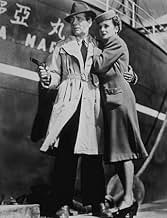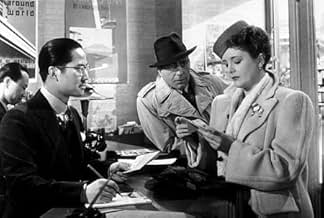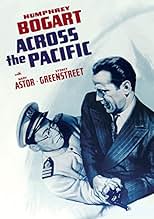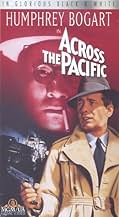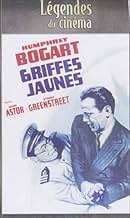IMDb RATING
6.8/10
5.6K
YOUR RATING
In December 1941, ex-army captain Rick Leland boards a Japanese ship heading to Asia via the Panama Canal where his Japanese hosts show interest in the American defense plans for the canal z... Read allIn December 1941, ex-army captain Rick Leland boards a Japanese ship heading to Asia via the Panama Canal where his Japanese hosts show interest in the American defense plans for the canal zone.In December 1941, ex-army captain Rick Leland boards a Japanese ship heading to Asia via the Panama Canal where his Japanese hosts show interest in the American defense plans for the canal zone.
- Directors
- Writers
- Stars
- Awards
- 1 win & 1 nomination total
Victor Sen Yung
- Joe Totsuiko
- (as Sen Young)
Lee Tong Foo
- Sam Wing On
- (as Lee Tung Foo)
- Directors
- Writers
- All cast & crew
- Production, box office & more at IMDbPro
Featured reviews
This film is okay -- watchable and even interesting -- but one can't help comparing it to "The Maltese Falcon" which appeared the previous year. Same principle actors -- Bogart, Mary Astor, Sidney Greenstreet -- no Peter Lorre fondling the handle of his cane, alas, and no gunsel -- and, for the most part, the same Director, John Huston. Huston was called up for Signal Corps duty halfway through filming and as a gag shot the scenes up to the point at which Bogart was strapped helplessly into a chair and surrounded by armed guards, a situation seemingly without the possibility of escape. Then Huston cheerfully said goodbye and walked off the set, leaving his replacement, Vincent Sherman, to try to figure out how to get Bogart free.
It may be unfair to compare "Across the Pacific" to a lucky shot like "The Maltese Falcon," but this film invites the comparison. Not just the same performers but similar lines -- "You're good, Angel, very, very good." But in Falcon the actors fit their fictional characters like enzymes accommodating themselves to a substrate. Here they are just actors playing familiar roles: the obese villain, the officer who's dishonorable discharge is faked so he can go undercover (Gary Cooper could have done as well, and in fact DID in a later movie), the innocent woman made to look bad because the enemy has imprisoned her dissolute father. The Japanese are all plain-vanilla bad guys, even the familiar young one who makes amusing wisecracks in American slang. And all the Japanese have real names like Tong, Chan, Loo, Fong, and Ahn. (To be fair, the last one is Korean, not Chinese.)
If the characters are not nearly as much fun to watch as in "The Maltese Falcon," the plot is no more than a simple war-time mystery involving secret information that the Japanese want to use to start the war by torpedoing the locks of the Panama Canal. Actually, the Japanese did develop such plans later in the war. They intended to deliver a handful of torpedo planes to the vicinity of the Canal in huge submarines, which were available. The planes were not, and the plans folded when the war ended.
In the movie, the characters move from New York to Canada, then board a Japanese steamer, back to New York, then to Panama, where they disembark. They travel from the Atlantic side of the canal to the Pacific -- but they never make it across the Pacific.
It may be unfair to compare "Across the Pacific" to a lucky shot like "The Maltese Falcon," but this film invites the comparison. Not just the same performers but similar lines -- "You're good, Angel, very, very good." But in Falcon the actors fit their fictional characters like enzymes accommodating themselves to a substrate. Here they are just actors playing familiar roles: the obese villain, the officer who's dishonorable discharge is faked so he can go undercover (Gary Cooper could have done as well, and in fact DID in a later movie), the innocent woman made to look bad because the enemy has imprisoned her dissolute father. The Japanese are all plain-vanilla bad guys, even the familiar young one who makes amusing wisecracks in American slang. And all the Japanese have real names like Tong, Chan, Loo, Fong, and Ahn. (To be fair, the last one is Korean, not Chinese.)
If the characters are not nearly as much fun to watch as in "The Maltese Falcon," the plot is no more than a simple war-time mystery involving secret information that the Japanese want to use to start the war by torpedoing the locks of the Panama Canal. Actually, the Japanese did develop such plans later in the war. They intended to deliver a handful of torpedo planes to the vicinity of the Canal in huge submarines, which were available. The planes were not, and the plans folded when the war ended.
In the movie, the characters move from New York to Canada, then board a Japanese steamer, back to New York, then to Panama, where they disembark. They travel from the Atlantic side of the canal to the Pacific -- but they never make it across the Pacific.
Films made around this time always have an interesting behind the scenes story, and "Across the Pacific" from 1942 is no different.
Rick Leland (Humphrey Bogart) is court-marshaled and booted out of the service; he then heads for Canada and attempts to enlist, but the Canadians know who he is and say they can't use him.
Leland then leaves on a Japanese ship for the Orient, making no bones about the fact that his talents are for sale! He meets an attractive woman, Alberta Marlow (Mary Astor) and one Dr. Lorenz (Sidney Greenstreet). Lorenz loves the Japanese and its people, and speaks the language very well.
You'll probably guess most of this.
This is a Maltese Falcon template, with the exception of the absence of Peter Lorre. John Huston directed, but when we entered the war, he left to do documentary films for the government. Vincent Sherman started the film at a difficult moment in the action, and he asked Huston how a particular situation would be resolved. Huston said, "That's your problem!" and left.
Originally this film had to do with stopping an attack on Pearl Harbor, but we all know what happened there, so the plot was changed to the Panama Canal.
I liked this film - there is a lot of light repartee between Bogart and Astor, which is fun and makes the film less intense than it might have been. They worked very well together. And you really can't beat Sidney Greenstreet when it comes to being slimy.
The majority of the Japanese in the movie were actually Chinese since most of the Japanese were interred, a black mark not often discussed, which is odd.
Some exciting action and solid work by all the cast.
Rick Leland (Humphrey Bogart) is court-marshaled and booted out of the service; he then heads for Canada and attempts to enlist, but the Canadians know who he is and say they can't use him.
Leland then leaves on a Japanese ship for the Orient, making no bones about the fact that his talents are for sale! He meets an attractive woman, Alberta Marlow (Mary Astor) and one Dr. Lorenz (Sidney Greenstreet). Lorenz loves the Japanese and its people, and speaks the language very well.
You'll probably guess most of this.
This is a Maltese Falcon template, with the exception of the absence of Peter Lorre. John Huston directed, but when we entered the war, he left to do documentary films for the government. Vincent Sherman started the film at a difficult moment in the action, and he asked Huston how a particular situation would be resolved. Huston said, "That's your problem!" and left.
Originally this film had to do with stopping an attack on Pearl Harbor, but we all know what happened there, so the plot was changed to the Panama Canal.
I liked this film - there is a lot of light repartee between Bogart and Astor, which is fun and makes the film less intense than it might have been. They worked very well together. And you really can't beat Sidney Greenstreet when it comes to being slimy.
The majority of the Japanese in the movie were actually Chinese since most of the Japanese were interred, a black mark not often discussed, which is odd.
Some exciting action and solid work by all the cast.
Good WW2 spy movie with the three leads and director from The Maltese Falcon. The plot is about Humphrey Bogart getting tangled up with baddie Sydney Greenstreet and love interest Mary Astor. Greenstreet's a Japanese sympathizer and is trying to recruit Bogie. Good luck with that, Gutman. Bogart is excellent playing a character he was totally at home playing: wisecracking tough guy ladies' man. Greenstreet is villainous as ever and perfect at it. Just as in Maltese Falcon, Mary Astor is playing a stunning beauty that makes heads turn. Just like in Maltese Falcon, she doesn't match the character description. Perhaps Huston had a bit of a crush. Otherwise I don't get her being cast in these types of parts at a time when the likes of Ingrid Bergman and Lana Turner were around. Still, despite that element of the casting being off, Astor does fine.
This movie has an interesting backstory. It was originally to be about a Japanese attack on Pearl Harbor but when that actually happened in real life, they changed it to Panama. They never changed the title, though, despite the movie taking place nowhere near the Pacific. Then John Huston got called to serve before filming was complete so Vincent Sherman had to step in. Oddly, it seems Huston was the only one who knew how the movie was supposed to end so Sherman had to make up the final fifteen minutes or so of the movie!
This movie has an interesting backstory. It was originally to be about a Japanese attack on Pearl Harbor but when that actually happened in real life, they changed it to Panama. They never changed the title, though, despite the movie taking place nowhere near the Pacific. Then John Huston got called to serve before filming was complete so Vincent Sherman had to step in. Oddly, it seems Huston was the only one who knew how the movie was supposed to end so Sherman had to make up the final fifteen minutes or so of the movie!
This serves as a nice companion piece to "The Maltese Falcon", but DON'T compare it the masterpiece or you won't enjoy it. Also, keep in mind, this was during the beginning of WWII (obviously), so expect your typical "all Japanese are evil" racial stereotypes. It is upsetting to see that films like these just heightened the US's paranoia, driving us to send everyone of Japanese descent to internment camps.
You're going to really enjoy this film if you've seen modern Pulp adventures like the Indiana Jones trilogy or Sky Captain (though don't expect to see ANY mystical/sci-fi elements involved). This has it all: a hard-boiled hero, exotic locales, constant plot twists and turns, colorful villains, and a mysterious woman.
Bogart, as (almost) always plays the same character he always plays. but boy, does he fit in SO well into this film. Mary Astor, while not the pretty face that she was built up to be here and in "The Maltese Falcon", gives another great performance, and unlike Bogart, she was always able to give characters in a similar vein (in this case, the mysterious woman), each their own personalities. Her Alberta Marlow is not at all like "schoolgirl" Brigid O'Shaughnessey, but (at least openly) tougher, a perfect match with Bogart during their exchanges of dialogue, while remaining to be extremely ambiguous, never making sure whether or not she's an ally or a femme fatale. When all is revealed, looking back on it things made perfect sense with her character's attitude.
Sydney Greenstreet adds another great villain to his own rogues gallery. Here he's a man obsessed with Japanese culture and way of life, so much that he has become apart of and accepted by "the enemy". Victor Sen Young, who played a great shark grinned scumbag in "The Letter", does good here, looking very happy that he at least was able to speak coherently for once in a motion picture.
Huston's direction is really worth looking at, especially visually stunning during a sequence at a movie theater. Without his obvious presence and Bogart, this film would have just been another propaganda story of espionage. Sadly, when he had to leave the film for war duty, the final scenes were shot by otherwise competent (but nothing special) director Vincent Sherman. The final 15 minutes seem extremely out of place with the rest of the film, and its a shame Huston wasn't around a little bit longer to round up what could have been a quintessential piece of a feature 40's pulp movie.
Worth seeing, its a film that falls short of greatness, but man is it entertaining.
You're going to really enjoy this film if you've seen modern Pulp adventures like the Indiana Jones trilogy or Sky Captain (though don't expect to see ANY mystical/sci-fi elements involved). This has it all: a hard-boiled hero, exotic locales, constant plot twists and turns, colorful villains, and a mysterious woman.
Bogart, as (almost) always plays the same character he always plays. but boy, does he fit in SO well into this film. Mary Astor, while not the pretty face that she was built up to be here and in "The Maltese Falcon", gives another great performance, and unlike Bogart, she was always able to give characters in a similar vein (in this case, the mysterious woman), each their own personalities. Her Alberta Marlow is not at all like "schoolgirl" Brigid O'Shaughnessey, but (at least openly) tougher, a perfect match with Bogart during their exchanges of dialogue, while remaining to be extremely ambiguous, never making sure whether or not she's an ally or a femme fatale. When all is revealed, looking back on it things made perfect sense with her character's attitude.
Sydney Greenstreet adds another great villain to his own rogues gallery. Here he's a man obsessed with Japanese culture and way of life, so much that he has become apart of and accepted by "the enemy". Victor Sen Young, who played a great shark grinned scumbag in "The Letter", does good here, looking very happy that he at least was able to speak coherently for once in a motion picture.
Huston's direction is really worth looking at, especially visually stunning during a sequence at a movie theater. Without his obvious presence and Bogart, this film would have just been another propaganda story of espionage. Sadly, when he had to leave the film for war duty, the final scenes were shot by otherwise competent (but nothing special) director Vincent Sherman. The final 15 minutes seem extremely out of place with the rest of the film, and its a shame Huston wasn't around a little bit longer to round up what could have been a quintessential piece of a feature 40's pulp movie.
Worth seeing, its a film that falls short of greatness, but man is it entertaining.
There are films that are so connected to their times, when taken out of context there's no rhyme, no reason for portrayals, but factor in the great betrayals, lets you accept the extremes, of paradigms. As Rick Leland is disgraced and then ejected, from a role that he would like to have perfected, leaves him in a tricky place, after losing all his face, and he's become quite disengaged and disaffected. On a boat he gets to meet curious souls, who have ambitions to dispose and take controls, as the layers are peeled back, looks like there might be an attack, by the folks who like to eat food out of bowls.
Of its time.
Of its time.
Did you know
- TriviaDirector Vincent Sherman met with John Huston just before Huston left the project to join the United States Army Signal Corps to shoot documentaries for the war effort.
The two directors conferred just before they were about to shoot the scene in which Leland is trapped in the movie theatre and three assassins are trying to kill him.
"How does he get out?" Sherman asked. Huston replied, "That's your problem! I'm off to the war!"
John Huston then went off to join the war effort before the film was finished, taking the film script with him, explaining "Bogie will know how to get out." The studio's solution to the problem was to discard Huston's footage of the impossible dilemma and write a new scenario. Vincent Sherman directed the final scenes.
- GoofsThe background for the opening titles is a map of the Panama Canal. The orientation of the map and the compass is correct, but the labeling of the map is incorrect. In fact, the Atlantic end of the canal and the city of Colon are at the upper left (Northwest), and the Pacific end of the canal and Panama City are at the lower right (Southeast). The map is correctly labeled behind the closing credits.
- Quotes
Rick Leland: [comparing his gun to Dr. Lorenz's, which he points at him] Remember: mine is bigger than yours!
- Crazy creditsOpening Card:
Governor's Island
New York
- Alternate versionsAlso available in a computer colorized version.
- ConnectionsFeatured in Frances Farmer Presents: Across the Pacific (1959)
- How long is Across the Pacific?Powered by Alexa
Details
- Runtime1 hour 37 minutes
- Color
- Aspect ratio
- 1.37 : 1
Contribute to this page
Suggest an edit or add missing content



